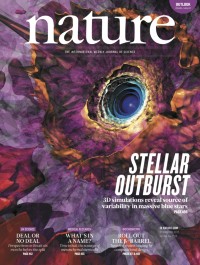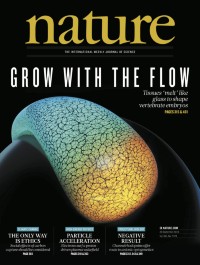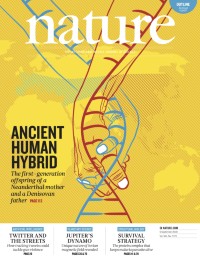Volume 561
-
No. 7724 27 September 2018
Stellar outburstThe cover image is a visualization of the turbulent envelope of a luminous blue variable star surrounding the central high-density core. As their name suggests, these massive, evolved stars display large variations in their luminosity and size. In this week’s issue, Yan-Fei Jiang and his collaborators report 3D models that suggest the mechanism behind this phenomenon. They find that helium opacity plays an important part in triggering the outbursts and in setting their effective temperature of around 9,000 kelvin. The team predicts that these stars should also show variability at the 10–30% level on a timescale of days.
Nature Outlook
-
No. 7723 20 September 2018
Grow with the flowThe cover is an artistic rendering of the elongation of the posterior body axis in a vertebrate embryo, highlighting the similarity between the physics of tissue morphogenesis and glass moulding. In this issue, Otger Campàs and his colleagues combine in vivo measurements of tissue mechanics, analysis of cellular dynamics and theoretical modelling to reveal the physical mechanism behind tissue morphogenesis in zebrafish embryos. The higher activity of cells at the posterior end of the body (glowing orange) ‘melts’ the tissue into a fluid-like state that enables remodelling. As body elongation proceeds, cells progressively become less active (blueish region), ‘freezing’ the tissue into a solid-like state that establishes tissue architecture. The fluid-to-solid transition is caused by cellular jamming of the foam-like (cellular) tissue architecture.
Nature Index
-
No. 7722 13 September 2018
Seconds outThe rise of multidrug-resistant bacteria is cause for considerable concern and the ‘ESKAPE’ group of pathogens present the most acute risk of untreatable infections. The Gram-negative bacteria within this group — iEscherichia coli, Klebsiella pneumoniae, Pseudomonas aeruginosa and Acinetobacter baumannii — are of particular concern because their dual-membrane envelope stops many drugs from reaching their targets. Despite extensive efforts, no new antibiotic active against Gram-negative bacteria has been approved in the past 50 years. In this week’s issue, Christopher Heise, Peter Smith and their colleagues present the chemical optimization of the arylomycin class of natural products into a potent, broad-spectrum drug that is active against clinical isolates of Gram-negative bacteria in vitro and in multiple in vivo infection models. The team believes this should pave the way for optimized arylomycin analogues to become much-needed new drugs for multidrug-resistant Gram-negative infections.
Spotlight
-
No. 7721 6 September 2018
Ancient human hybridIn this week’s issue, a team led by Viviane Slon and Svante Pääbo reveals the genome of a first-generation offspring of mixed Neanderthal and Denisovan parentage. The genome of the ancient adolescent was obtained from a bone fragment recovered from the Denisova Cave in the Altai Mountains of Siberia. The young female was at least 13 years old when she died 50,000–90,000 years ago. Neanderthals and Denisovans coexisted in Eurasia, and some specimens of mixed heritage have previously been found. But the latest discovery is the first time a first-generation child has been identified, providing direct evidence of interbreeding between the two groups. The researchers suggest that interbreeding between the groups may have been common when they met but that limited interactions allowed the groups to remain genetically distinct.
Nature Outline




